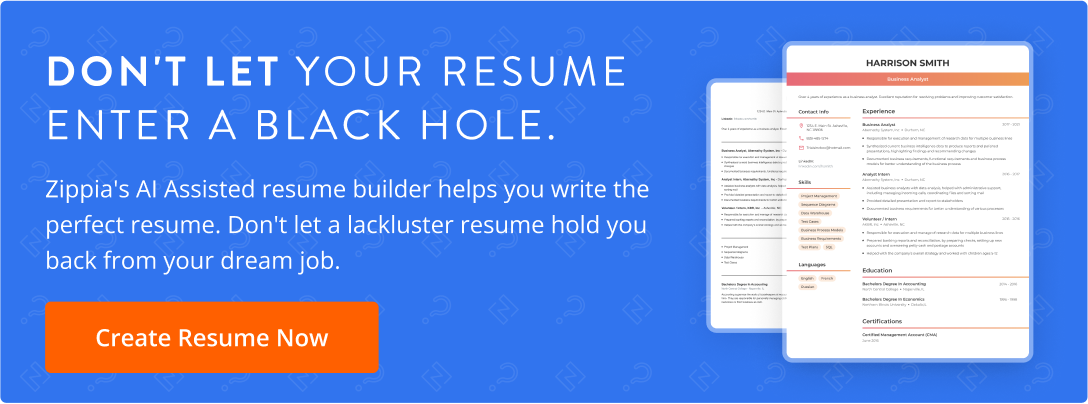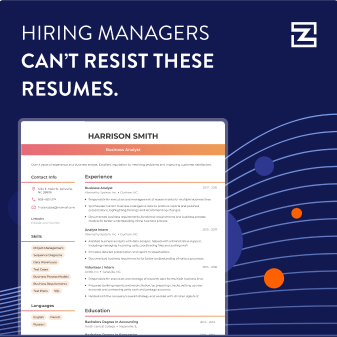- HR Statistics
- Average Labor Cost Percent Of Sales
- Average Time to Reach Profitability At A Startup
- Office Space Per Employee
- Recruitment Statistics
- Employee Engagement Statistics
- Work-Life Balance Statistics
- BYOD Statistics
- Paternity Leave Statistics
- Onboarding Statistics
- Average Paid Maternity Leave In Us
- Average Cost Of A Bad Hire
- Employee Theft Statistics
- Paid Family Leave Statistics
- Cost Of Hiring Statistics
- Employee Turnover Statistics
- Average Cost Of Employer Sponsored Health Insurance Statistics
- Sexual Harassment In The Workplace Statistics
- HR Statistics
- PTO Statistics
- Social Media Recruitment Statistics
- Hiring Statistics
- Out Of Prison Employment Statistics
Work-life balance research summary. Work-life balance isn’t always easy to achieve, especially now that our mobile devices easily keep us connected to work. Separating and balancing professional and personal life has become more difficult and more important than ever. Here are some valuable work-life balance statistics:
-
60% of employees believe they have a good work-life balance.
-
77% of employees have experienced burnout at least once in their current jobs.
-
72% of workers believe work-life balance is a very important factor when choosing a job, and 57% of job-seekers say a poor work-life balance is a dealbreaker when they’re considering a new job.
-
43% more remote employees work over 40 hours a week than onsite employees do.
-
While personal perfectionism is the biggest barrier to good work-life balance, 67.2% of workers report that some aspect of their work, colleagues, or corporate culture is the biggest culprit behind poor work-life balance.
For further analysis, we broke down the data in the following ways:
Employee Opinions | Benefits of Strong Work-life Balance | Challenges to Work-life Balance | Remote vs. In-office Effects on Work-life Balance Statistics
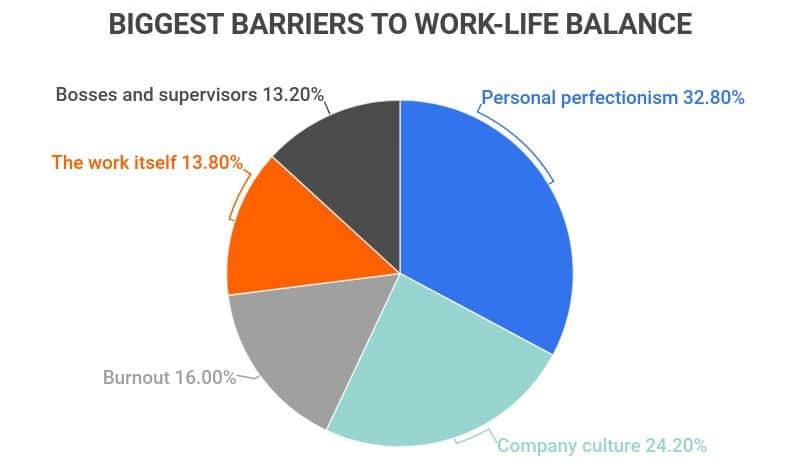
Work-life balance statistics by employee reporting
Work-life balance can be difficult to track, but luckily, many employees to report their status in surveys and polls. To find out more about employee opinions on their current work-life balance, here are some insights our research uncovered:
-
60% of employees say they’re able to effectively balance their work and personal commitments.
This percentage is from a 2021 survey, and in 2020, 65% said the same thing.
These statistics are coupled with 29% of respondents saying they often dread going to work in 2021 and 23% saying the same in 2020.
-
77% of surveyed employees say they’ve experienced burnout at their current job.
51% have experienced burnout more than once.
In addition, the burnout rate is higher (84%) with workers who say they aren’t passionate about their job.
-
83% of workers say their personal relationships are negatively impacted by burnout from work.
This, combined with the fact that 25% of employees never or rarely take days off of work, means that a significant number of employees are missing out on meaningful time and connection with their loved ones because of their jobs.
-
The majority of employees say that they regularly check their work email during their off-hours.
Only 38% of those surveyed say that checking their work email outside of working hours is unnecessary.
Employees aged 30 and above are less willing to check their job communications at home than those under 30, but 52% said they were still willing to.
70% of workers under 30 said the same.
-
48% of employees call themselves workaholics.
On average, employees work four hours per week that they don’t get paid for and spend another four hours outside of the office thinking (or stressing) about work each week.

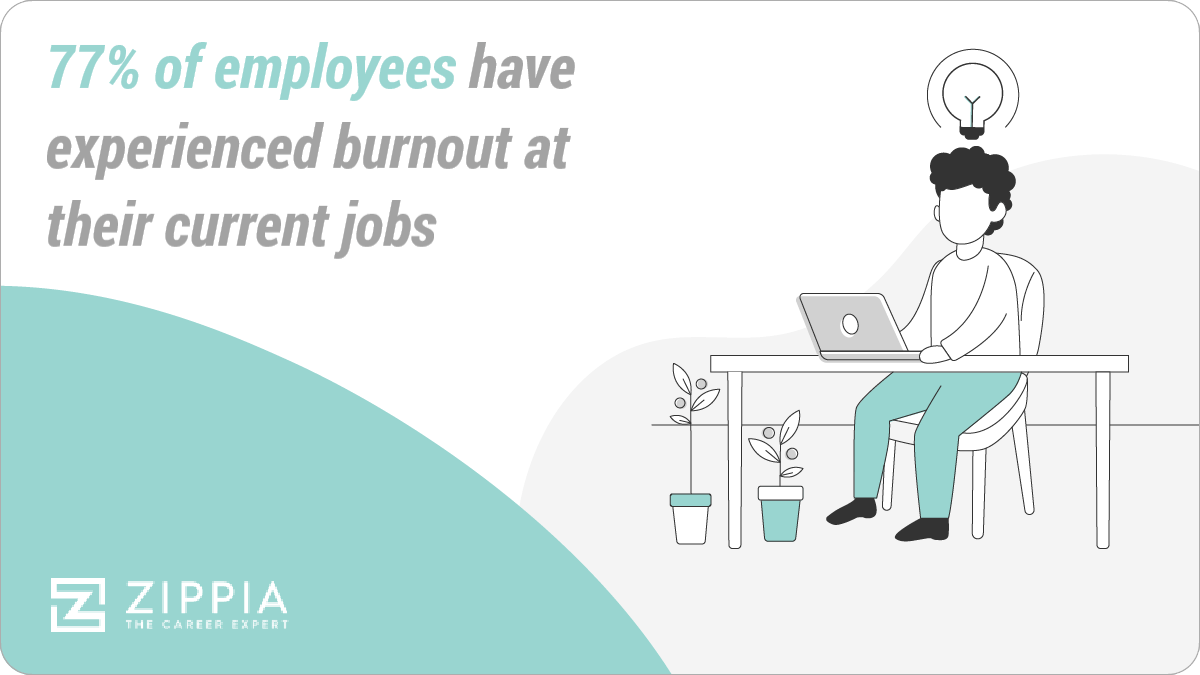
Employee opinions on work-life balance statistics
Work-life balance is thought about differently by different employees. Some find it very important, while others don’t. Some also consider work-life balance while job hunting, while others don’t. Here are the facts:
-
72% of employees say a good work-life balance is very important to them.
In contrast, only 6% of those surveyed said that a work-life balance was not very important, not important at all, or that they had no opinion on it.
-
57% of surveyed employees say a poor work-life balance is a deal-breaker when considering a job.
This is the second most popular reason employees gave for being willing to turn down a job offer. The most popular is a long commute, which 58% of those surveyed said would be a deal-breaker.
-
66% of workers say they often skip at least one meal per day because of work.
Some miss meals because they just don’t have time to eat at work, while others say they skip because they’re stressed about work. 42% of these same workers say they worry there will be issues at work when they’re away.
-
79% of workers believe that a flexible schedule allows for a better work-life balance.
Having a flexible job allows for a better work-life balance because employees will have more control on their schedule and when they work. More flexibility means spending more time with friends and family.
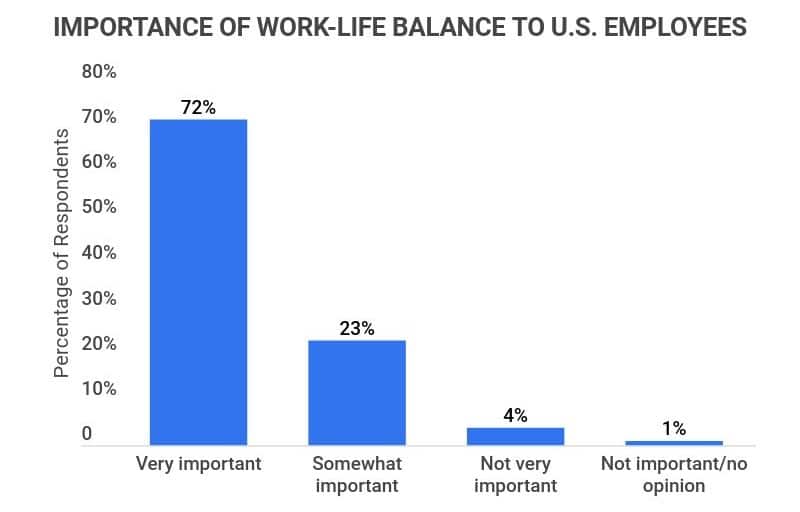
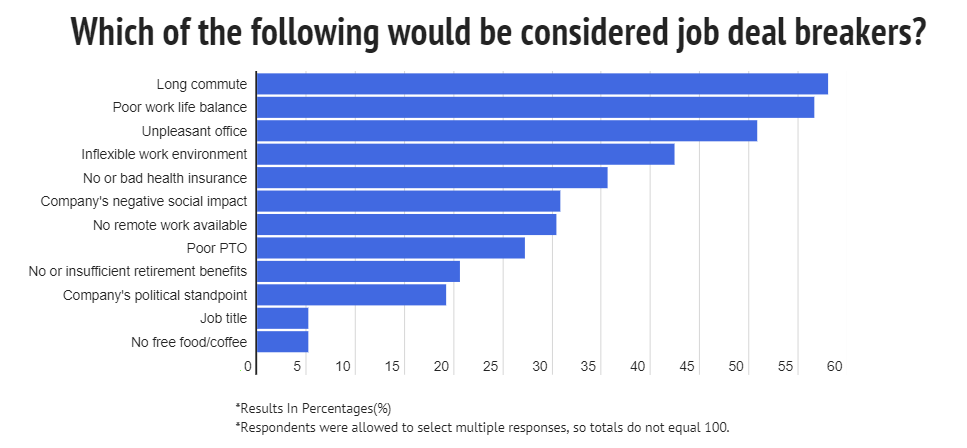
Benefits of strong work-life balance statistics
A strong work-life balance comes with many benefits for employers and employees. From increased retention and performance to more job satisfaction, here are some key statistics:
-
89% of surveyed HR professionals saw an increase in employee retention after implementing flexible work policies.
On the flip side, over 25% of employees who felt they had no support from their employers in maintaining a healthy work-life balance planned to find a different job within two years. Only 17% of employees who did feel supported planned to do the same.
This is important for companies to note because, on average, employee turnover costs the organization 21% of the employee’s salary.
-
Unscheduled sick and vacation days cost companies between $2,600 and $3,600 per employee per year.
Employees who say they have high stress levels spend almost 50% more on healthcare costs than those who aren’t under so much strain.
Stressed employees get sick more often, leading to more unanticipated employee absences among those who have poor work-life balances, which, in turn, leads to more expenses and less productivity for their employers.
-
90% of employees say that a flexible work schedule would increase morale.
Giving employees the freedom to adjust their work schedules to the rest of their responsibilities makes for happier employees, and happier employees typically mean increased productivity and less turnover.
Work-life balance challenges statistics
Achieving work-life balance has its challenges, especially for employees working with large projects or long hours. Here are some of those major work-life balance challenges outlined:
-
31% of surveyed employees say that a lack of support or recognition from their leaders was the biggest driver of their burnout.
30% said that unrealistic deadlines or expectations were the driving factors for them, and 29% pointed to long working hours or working on weekends as the cause of their burnout.
-
Even though 78% of employees believe their employers are responsible for supporting their physical and mental well-being, only 42% offer their employees wellness programs.
In addition, 41% of employees say they’d take a 10% pay cut if it meant working for an organization that cared more about their health and wellbeing than their current employer does.
-
32.8% of surveyed workers say that personal perfectionism is the biggest impediment when seeking a healthy work-life balance.
The next-highest reason was company culture, with 24.2% of respondents saying this made it difficult to balance their personal and professional lives.
After that, 13.8% chalk up poor work-life balances to work itself, 13.2% to their bosses and supervisors, and 16% to burnout.
Barriers to a healthy work-life balance
| Barrier | % of Respondents |
|---|---|
| Personal perfectionism | 32.8% |
| Company culture | 24.2% |
| Burnout | 16% |
| The work itself | 13.8% |
| Bosses and supervisors | 13.2% |
Remote vs. in-office effects on work-life balance statistics
Work-life balance has been forever changed by the impacts of the COVID-19 pandemic. Many people reacted to the changes they experienced moving to remote work, positively and negatively.
-
Employees who worked from home were 13% more productive than their colleagues still working in the office, found in one study.
-
45% of workers who began working remotely during the COVID-19 pandemic say they worked more hours than when working in the office.
-
The number of remote workers who said they work over 40 hours a week was 43% higher than those who said the same and worked in an office.
-
22% more employees who work from home full-time say they’re happy with their jobs than those who work in the office full-time.
-
91% of surveyed employees decided to work remotely because they wanted a better work-life balance.
Work-life balance statistics FAQ
-
What does having a work-life balance mean?
Having a work-life balance means fulfilling your work commitments while still having the time and energy to fulfill your personal commitments.
The specifics of this will look different for every individual, but generally, a good work-life balance gives you the ability to perform well at work while still having a fulfilling personal life and healthy relationships.
For example, for many parents, this may look like being able to go to their children’s school functions during the day, stay home with them when they’re sick, and have their evenings and weekends available to spend time with their families while still keeping up with all of their work.
For a young person who enjoys the outdoors, a good work-life balance might mean being able to start and end early so that they can get a hike in with friends before it gets dark.
The bottom line is that a good work-life balance allows employees to minimize stress levels and have separate personal and work lives that don’t drain each other.
-
What causes poor work-life balance?
A combination of perfectionism, company culture, and demanding jobs causes poor work-life balance. The exact reasons will depend on each individual, but these are some of the most common.
Many workers get caught up in trying to do their job perfectly or outdo everyone else, resulting in unnecessarily long hours and high stress levels. Others feel pressured by their company culture to never take a break or are given too much work to do within a reasonable amount of time.
All of these result in work becoming the top priority in a person’s life, which means personal relationships, hobbies, and rest fall by the wayside, effectively destroying their work-life balance.
-
How do you improve your work-life balance?
You improve your work-life balance by setting and sticking to clear boundaries. This means requiring yourself to use your vacation days whether your boss encourages you to or not, giving yourself a nonnegotiable quitting time, and setting aside times where you don’t check your work email or phone.
These steps may look different for you depending on your job, but whatever you choose to do, you should communicate with your boss to explain when you’ll be reachable and when you won’t be. Usually, they’ll be able to work with that. If they can’t, that might be your sign of taking more drastic action and finding a new employer.
-
Is work-life balance important to employees?
Yes, work-life balance is important to employees. 72% of workers consider work-life balance an important factor when considering the quality of a job, and 57% of job-seekers report that poor work-life balance is a deal-breaker that will cause them to not accept an offer.
-
What are the benefits of having a good work-life balance?
The benefits of having a good work-life balance include increased employee morale, better talent acquisition and retention, and increased productivity. 90% of employees report that flexible scheduling increases their morale at work, and 89% of HR professionals saw an increase in employee retention after implementing flexible work policies.
Additionally, employees with higher rates of stress and less flexible schedules take more unscheduled sick days, costing up to $3,600 per employee each year.
Conclusion
A good work-life balance is vital to both employees’ and companies’ health. 89% of companies that implemented a more flexible work schedule saw a boost in employee retention, saving those companies thousands of dollars in turnover costs and productivity.
Helping employees strike a healthy work-life balance also improves companies’ recruiting, as 57% of workers say a poor work-life balance is a dealbreaker for them when looking for a new job.
Even with these clear benefits to companies, only 41% of employees say their employers offer wellness programs to help support them in their attempts to balance work with their personal lives. In addition, 31% of employees said that a simple lack of support and recognition from their superiors was the main driver in their burnout.
References
-
Statista. “Percentage of U.S. Employees Who had Select Attitudes About Work in 2020 and 2021.” Accessed on October 15, 2021.
-
Deloitte. “Workplace Burnout Survey.” Accessed on October 15, 2021.
-
Business Insider. “Americans are Definitely Workaholics.” Accessed on October 15, 2021.
-
Clockify. “Workaholism Facts.” Accessed on October 15, 2021.
-
Statista. “Importance of Work-Life Balance Among Employees in the U.S. in 2018.” Accessed on October 15, 2021.
-
Zippia. “2021 Job Seeker Report: What Workers Want (and Expect) in a Post-COVID Job Market.” Accessed on October 15, 2021.
-
Inc. “How Work Life Balance Can Keep Your Employees Happy and Your Business Healthy.” Accessed on October 15, 2021.
-
Staples. “Staples Workplace Survey 2019.” Accessed on October 15, 2021.
-
GCU. “Work-Life Balance Stats Among Business Professionals.” Accessed on October 15, 2021.
-
Stanford Business. “Does Working From Home Work? Evidence From a Chinese Experiment.” Accessed on October 15, 2021.
-
SHRM. “Remote Employees Are Working Longer Than Before.” Accessed on October 15, 2021.
-
Business Insider. “Study Says That Remote Workers Are Happier and Stay in Jobs Longer.” Accessed on October 15, 2021.
-
Apollo Technical. ““10 Workplace Statistics on Work-life Balance That May Surprise You”” Accessed on February 17, 2023.
- HR Statistics
- Average Labor Cost Percent Of Sales
- Average Time to Reach Profitability At A Startup
- Office Space Per Employee
- Recruitment Statistics
- Employee Engagement Statistics
- Work-Life Balance Statistics
- BYOD Statistics
- Paternity Leave Statistics
- Onboarding Statistics
- Average Paid Maternity Leave In Us
- Average Cost Of A Bad Hire
- Employee Theft Statistics
- Paid Family Leave Statistics
- Cost Of Hiring Statistics
- Employee Turnover Statistics
- Average Cost Of Employer Sponsored Health Insurance Statistics
- Sexual Harassment In The Workplace Statistics
- HR Statistics
- PTO Statistics
- Social Media Recruitment Statistics
- Hiring Statistics
- Out Of Prison Employment Statistics


